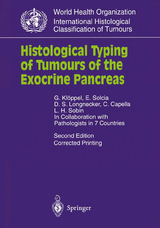Histological Typing of Tumours of the Exocrine Pancreas
Springer Berlin (Verlag)
978-3-540-60280-4 (ISBN)
This is a histological classification of tumours and tumour-like lesions of the exocrine pancreas which also includes those tu mours showing a mixture of exocrine and endocrine elements. The classification is based principally on standard microscopic observations, but whenever indicated it incorporates diagnosti cally valuable immunohistological findings. In addition, the most important immunohistological findings which are helpful in cat egorizing pancreatic tumours are summarised in Table 1. The major guideline of this classification scheme is the group ing of the pancreatic exocrine tumours according to their biologi cal behaviour. Thus, the neoplasms are broadly divided into benign (adenoma) and malignant tumours (carcinoma). How ever, in recent years we have learned that this division is not a sharp but rather a gradual transition. We therefore added a third group which we call "tumours of uncertain malignant potential" representing a borderline category analogous to that recognized for some ovarian tumours. This group includes mucinous cystic tumour, intraductal papillary-mucinous tumour and solid pseudopapillary tumour. These neoplasms are defined by the grade of dysplasia and/or potential to become malignant. Mucinous cystic tumours of uncertain malignant potential, for instance, exhibit moderate epithelial dysplasia, but do not show severe dysplasia/carcinoma in situ changes, nor carcinomatous invasion of the cyst wall or the adjacent pancreatic tissue. Solid pseudopapillary tumour has a benign looking histological ap pearance, but metastases may occur. Biologically, all these neoplasms are primarily slow-growing lesions and have an excel lent prognosis when adequately treated by complete resection.
Günter Klöppel, Professor emeritus für Pathologie, Institut für Pathologie, Technische Universität München und Christian-Albrechts-Universität zu Kiel. ünter Klöppel hat sich durch zahlreiche wichtige Beiträge auf dem Gebiet der Pankreaspathologie und der Pathologie der neuroendokrinen Tumoren ausgezeichnet. Diese entstanden zu einem großen Teil am Institut für Pathologie der Universität Kiel, das er nach seinem Wechsel von Brüssel nach Kiel über 13 Jahre leitete und zu einer führenden Institution machte. Nach seiner Emeritierung hat er seine wissenschaftlichen Tätigkeiten am Institut für Pathologie der Technischen Universität München fortgesetzt. Die wichtigsten wissenschaftlichen Beiträge erfolgten auf dem Gebiet der kindlichen Nesidioblastosen, der Vorläuferläsionen des Pankreaskarzinoms und ihrer molekularen Progression, der Beschreibung und Klassifizierung spezieller Pankreastumoren, der Pathogenese der alkoholischen und autoimmunen Pankreatitis und der Klassifikation gastroenteropankreatischer neuroendokriner Tumoren. Die molekulare Genese der neuroendokrinen Neoplasien des Duodenum und Pankreas bei MEN1 wurden von seinen Mitarbeitern und ihm erstmals auf Gewebsebene erforscht und eingehend charakterisiert. Aufbauend auf diesen Arbeiten wurde eine Hypothese zur schrittweisen molekularen Entstehung neuroendokriner Tumoren aus frühen und späten Stammzellen entwickelt. ünter Klöppel hat zahlreiche wissenschaftliche Preise gewonnen und ist Mitglied der Deutschen Akademie der Wissenschaften Leopoldina.
Histological Classification of Tumours of the Exocrine Pancreas.- Definitions and Explanatory Notes.- Epithelial Tumours.- Nonepithelial Tumours.- Secondary Tumours.- Tumour-like Lesions.- Illustrations.
| Erscheint lt. Verlag | 19.2.1996 |
|---|---|
| Reihe/Serie | WHO. World Health Organization. International Histological Classification of Tumours |
| Zusatzinfo | XI, 61 p. 63 illus., 60 illus. in color. |
| Verlagsort | Berlin |
| Sprache | englisch |
| Maße | 170 x 242 mm |
| Gewicht | 204 g |
| Themenwelt | Medizinische Fachgebiete ► Chirurgie ► Viszeralchirurgie |
| Medizinische Fachgebiete ► Innere Medizin ► Gastroenterologie | |
| Studium ► 2. Studienabschnitt (Klinik) ► Pathologie | |
| Schlagworte | Bauchspeicheldrüse • Bauchspeicheldrüsenkrankheit • Bauchspeicheldrüse / Pankreas • classification • Exocrine Tumours • Exokrine Tumoren • HC/Medizin/Klinische Fächer • histological typing • Histologische Typierung • Histology • Klassifikation • pancreas • Pankreas • Tumor |
| ISBN-10 | 3-540-60280-1 / 3540602801 |
| ISBN-13 | 978-3-540-60280-4 / 9783540602804 |
| Zustand | Neuware |
| Haben Sie eine Frage zum Produkt? |
aus dem Bereich




